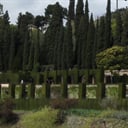In which country do parts of Hadrian's Wall still remain?
Hadrian's Wall, also called the Roman Wall, Picts' Wall, or Vallum Hadriani in Latin, was a defensive fortification in the Roman province of Britannia, begun in AD 122 in the reign of the emperor Hadrian. It ran from the banks of the River Tyne near the North Sea to the Solway Firth on the Irish Sea, and was the northern limit of the Roman Empire. Hadrian was a Roman emperor from 117 to 138.
A significant portion of the wall still stands and can be followed on foot along the adjoining Hadrian's Wall Path. The largest Roman artifact anywhere, it runs a total of 73 miles in northern England. Regarded as a British cultural icon, Hadrian's Wall is one of Britain's major ancient tourist attractions.
According to restored sandstone fragments which date from 118 or 119, it was Hadrian's wish to keep "intact the empire", which had been imposed on him via "divine instruction". Another possible explanation for the wall is the degree of control it would have provided over immigration, smuggling and customs. Construction started in AD 122 and was largely completed in six years. Construction started in the east and proceeded westwards, with soldiers from all three of the occupying Roman legions participating in the work.
More Info:
en.m.wikipedia.org











